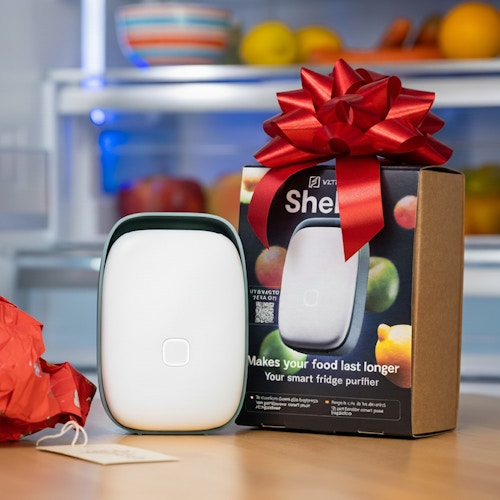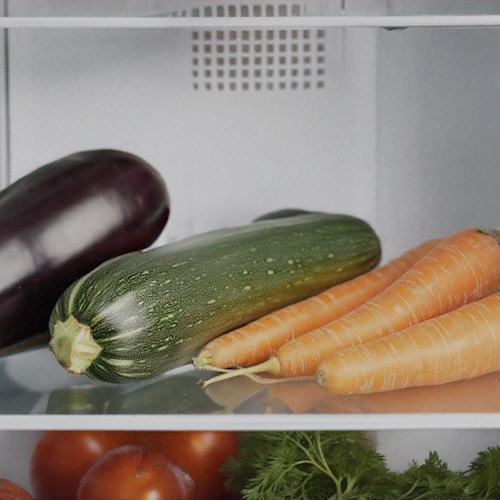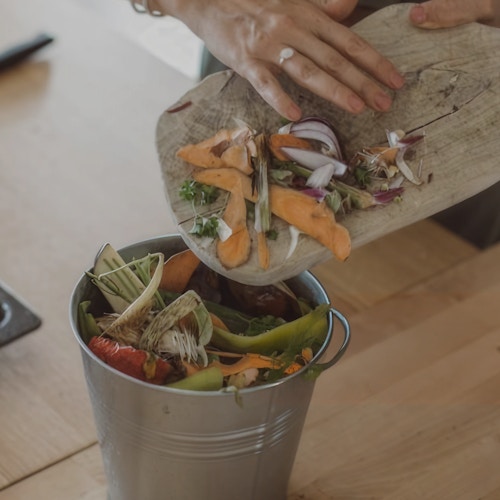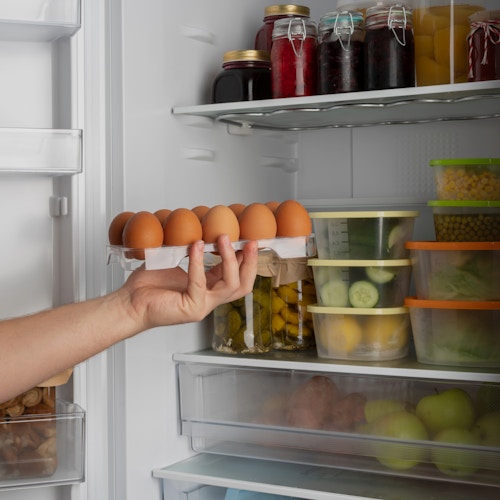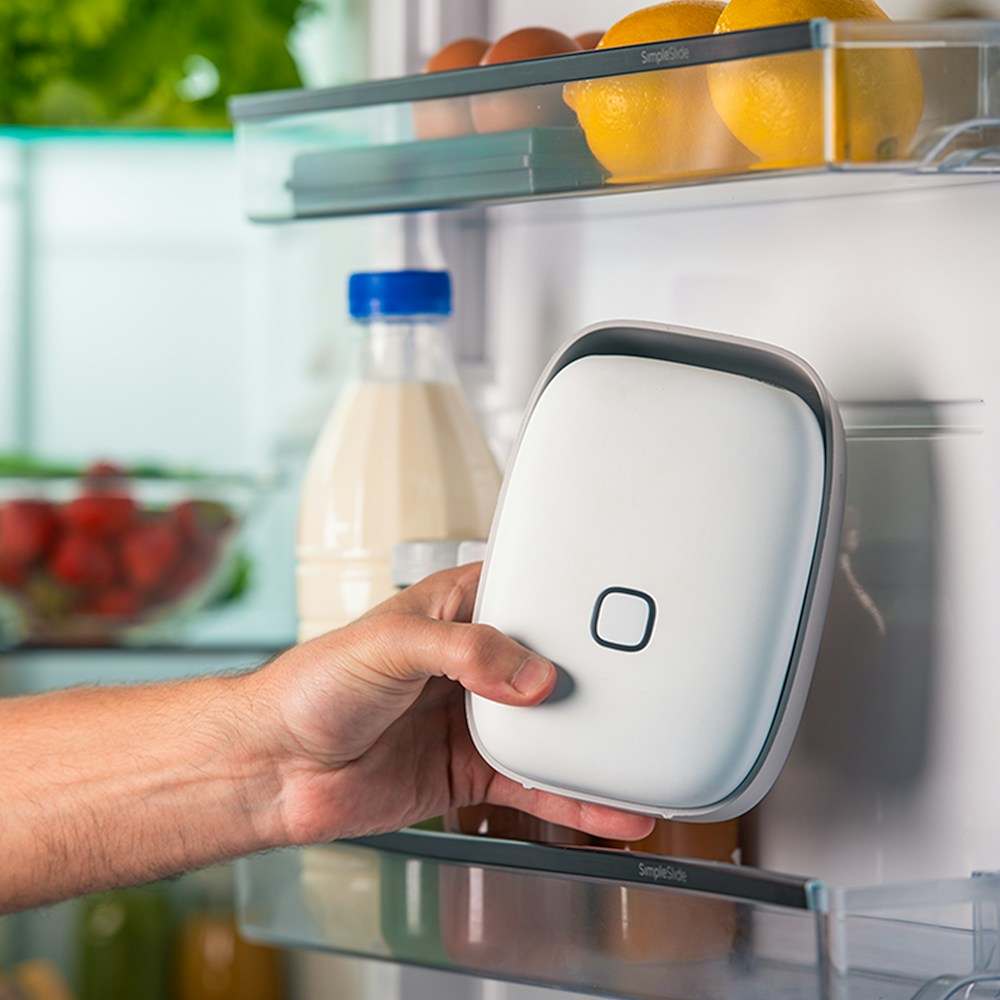
How to best store fruits and vegetables in the fridge
→
Did you know? Proper food storage can make a huge difference! By storing your fruits and vegetables the right way, you can keep them fresh and flavourful, reduce waste, and always have high-quality food ready when you need it.
- How to properly store fruits and vegetables in the fridge
- Which fruits should be stored in the fridge and which ones shouldn’t?
- What causes food to spoil? Here are the hidden enemies of your fridge
- How can Shelfy help with storing fruits and vegetables?
- How does Shelfy work?
- Shelfy and Vitesy Hub: The Food Library

How to properly store fruits and vegetables in the fridge
Who hasn’t opened the fridge only to find that some fruits or vegetables have gone bad? Not only is this frustrating, but it can also lead to food waste and the growth of bacteria, which can harm your health in the long run. Properly storing fruits and vegetables helps preserve their freshness, flavour, and nutrients while preventing unpleasant odors and mold formation. But how can we avoid spoilage and extend the life of our food?
Here are a few simple tips to optimize food storage in your fridge. Learn how to keep your produce fresh and nutritious for longer!
Set the temperature between 4°C and 6°C to slow down ripening and decomposition: regularly check the fridge temperature to ensure it’s ideal. Use the designated drawers to maintain the proper humidity for freshness, but don’t overcrowd them to ensure good air circulation.
Avoid storing fruits and vegetables alongside foods with strong odors, like onions and garlic, to prevent flavor contamination. Finally, use protective sheets or mats in the drawers to absorb excess moisture and prevent mold.
Where to place food in the fridge?
The arrangement of your food in the fridge directly affects its freshness and shelf life. Each compartment in the fridge serves a specific purpose, and knowing how to use them properly can help you avoid waste, preserve nutrients, and prevent bacterial growth. Here’s how to organize your fridge to make the most of your grocery store haul:
- Top shelf: Desserts, cheeses, jams
- Middle shelf: Deli meats, cooked vegetables, sauces, cooked foods, leftovers, cakes, and items labeled "store in the fridge after opening," dairy products
- Bottom shelf: Raw meat, fish, poultry, raw foods
- Crisper drawers: Store almost all fruits and vegetables in the bottom of the fridge (8–10°C), where humidity is higher (80–90%).
- Fridge door: Items that need minimal refrigeration, like water, drinks, mustard, and eggs.

Which fruits go in the fridge and which don’t?
Storing fresh produce correctly might seem tricky, but by following these simple guidelines, you can keep your fruits and vegetables fresh and tasty for longer, reduce waste, and improve your diet’s quality.
Garlic, onion, and shallots: Keep them outside the fridge in a cool, dry, and well-ventilated place. Storing them in the fridge may cause mold due to the humidity. A basket or paper bag is the best option.
Citrus fruits: Should you refrigerate them? Citrus fruits like oranges and lemons can be kept in the fridge, but their moisture might make them taste bitter. If you decide to refrigerate them, place them in the fruit drawer to avoid moisture exposure.
Bananas, kiwi, mango, and avocados: Always store bananas at room temperature, never in the fridge, to prevent the skin from darkening. The same goes for kiwi, mango, and avocado: store them outside the fridge until they ripen. Once ripe, you can refrigerate them to extend freshness.
Strawberries: Store them in the fridge and consume them quickly. After washing and cutting, refrigerate them but be mindful of moisture, as it can lead to mold.
Leafy greens and lettuce: Keep them in the fridge’s designated drawers, where the temperature is perfect for freshness. Consume within 3 days. Pre-washed, packaged greens can go on the shelves.
Apples: Can be stored in the fridge or at room temperature. However, if you refrigerate them, make sure to keep them separate from other ripe fruits to avoid the ethylene gas from speeding up their ripening process.
Tomatoes: Never store them in the fridge! Although the fridge slows down their spoilage, it negatively affects their taste and texture. Store tomatoes at room temperature and consume them quickly to enjoy their fresh flavor.

What causes food to spoil? Here are the hidden enemies in your fridge
The fridge is essential for keeping food fresh, but if not used correctly, it can speed up food spoilage.
Temperature, overloading the fridge, and ethylene gas are some of the main culprits in rapid food deterioration.
The fridge’s internal temperature isn’t always uniform. Cold air sinks, while warm air rises, making the bottom shelves the coldest and the top (especially the door) the warmest. This means some foods need specific spots to avoid rapid spoilage.
What's the solution?
Keep your fridge at 4°C and place food according to its ideal temperature. Store raw meat and fish on the bottom shelves, cooked foods on the top, and fruits and vegetables in the designated crisper drawers to keep them fresher for longer.
Released by certain fruits like apples, bananas, tomatoes, and kiwi, ethylene gas accelerates ripening and can cause other foods, particularly leafy greens, to spoil prematurely.

How to avoid It?
Store fruits and vegetables separately in the fridge! Keep ethylene-producing fruits away from non-producers, like leafy greens, to prevent premature ripening. For example, keep bananas and apples away from carrots or broccoli.
Also, avoid overcrowding the fridge. Too many items can block the cold air circulation, which speeds up spoilage. Leave enough space for air to flow freely and preserve freshness.

How can Shelfy help with storing fruits and vegetables?
Shelfy is designed to improve your fridge’s internal environment, allowing fruits and vegetables to last longer. It does this through three main mechanisms:
Reduction of ethylene gas, mold, and bacteria:
Ethylene gas naturally produced by fruits and vegetables accelerates ripening. Shelfy reduces the concentration of this gas, slowing down deterioration. It also neutralizes up to 97.5% of bacteria and mold responsible for food spoilage.
Odor absorption:
Shelfy helps reduce up to 80% of persistent odors, such as fish and cheese, that can affect the flavor of your food, keeping the fridge fresh and hygienic.

How does Shelfy work?
Shelfy uses an innovative photocatalysis-based technology that harnesses light to activate a process that destroys bacteria, mold, and ethylene gas. After charging the battery, Shelfy is placed in the fridge—preferably in the center or in the fruit and vegetable drawers.
It can be set to different modes (Eco, Crisper, Performance) via the Vitesy Hub app, optimizing its function according to your needs. The app also allows you to control the fridge’s temperature, humidity levels, and door openings, offering tips to improve food storage. Fruits and vegetables stay fresh up to 40% longer, reducing waste and helping you manage your food better.
Shelfy and Vitesy Hub: The Food Library
If you want to make the most of Shelfy and reduce food waste, the Food Library feature in the Vitesy Hub app is the tool you need. This simple feature helps guide you in the optimal storage of fruits, vegetables, and other foods in your fridge. With Shelfy’s help, you can keep your food fresh longer, reduce waste, and always have fresh ingredients on hand.
How it works?
It’s easy to use! Simply open the Vitesy Hub app, navigate to the Food Library section in the main menu, and search for any food item—from apples to lettuce. You’ll get personalized tips on how to store it best in the fridge.
Why it’s useful:
- Personalized tips help you store foods correctly and prevent premature spoilage and food waste.
- You’ll always know what’s in season, allowing you to eat healthily and sustainably.
- If you’re unsure whether to store a food item in or out of the fridge, the app will give you an answer.
With the Food Library in Vitesy Hub, keeping your food fresh and long-lasting is easier than ever, reducing waste and improving your kitchen’s quality!

